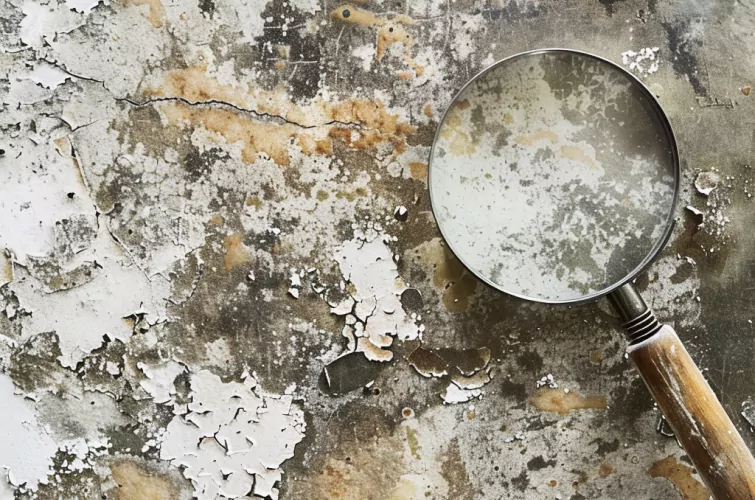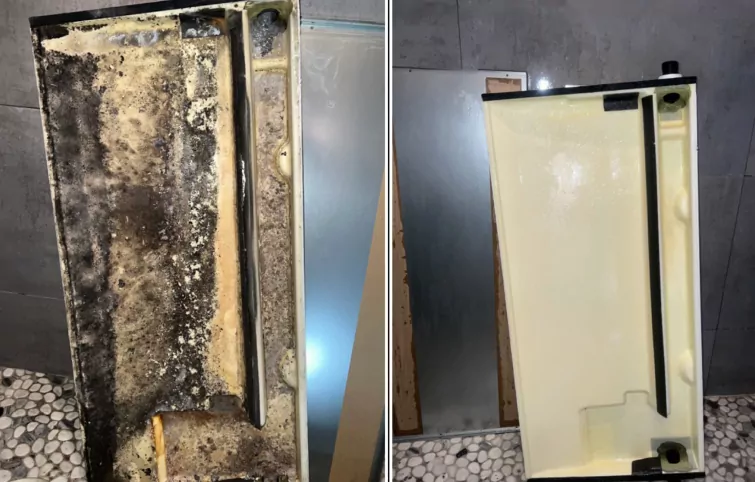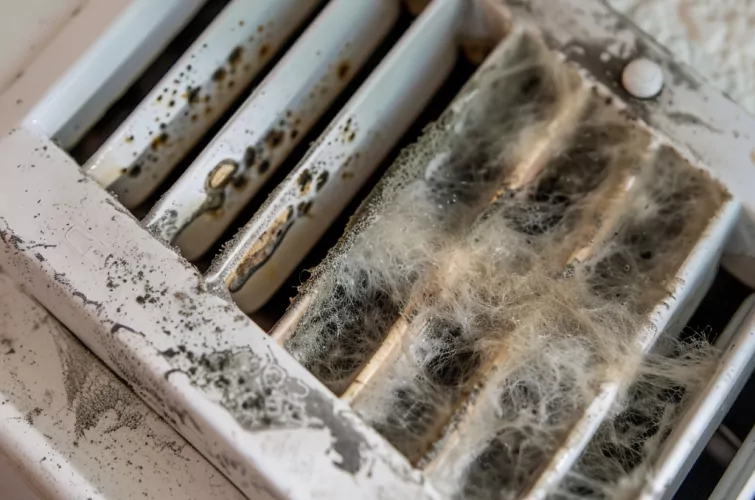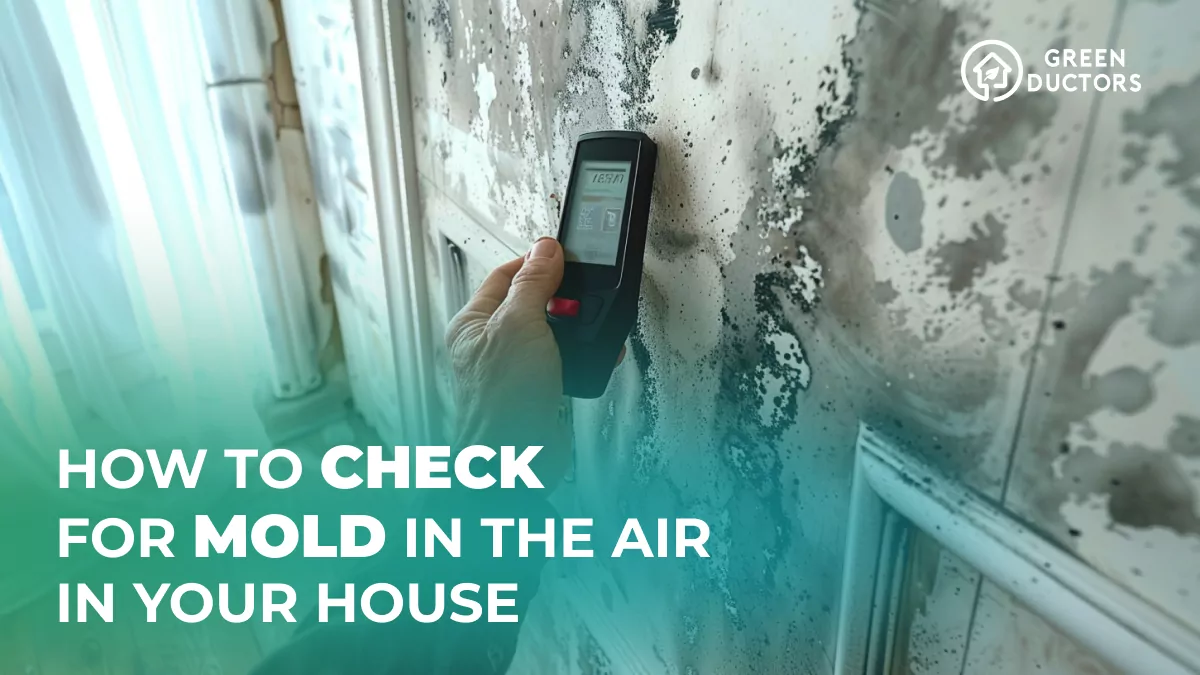Mold – the very word can cause us to feel anxious and worried when we find it in our living space. Even without knowing about all the terrible consequences it entails, mold spores can frighten anyone. But it’s much more than just an ugly black pattern on your walls, ceiling, or floor. Mold is the most common source of indoor air quality problems. It can cause a variety of health issues, as well as damage our property and belongings if not detected and remediated in time.

The ideal environment for mold and mildew to grow is in damp areas such as the bathroom. However, it can also find its way into other rooms in your home. One of the biggest problems with mold is that it’s not always visible, so let’s talk about it. In this step-by-step guide, we’ll cover how to check for mold in your house and provide you with practical tips on how to prevent and address this common problem.
How To Detect Mold In Your House?
Mold is a type of fungus that can grow almost anywhere in your home. It thrives in moist environments with high humidity and temperatures between 77°F and 86°F. It reproduces through tiny spores that travel through the air and can settle and grow on various surfaces. Mold can come in a variety of shapes and sizes, but most often it grows in cottony, velvety, or feathery tufts. So how can you find mold in your house? Sometimes it’s enough to simply look.

Mold can appear in a multitude of colors, including black, green, white, and even orange. It often presents as a patchy or fuzzy growth on surfaces such as walls, ceilings, and floors, so it can sometimes be confused with dirt. A musty, earthy odor is a sure sign that you might have mold in your environment, even if it’s not immediately visible. Peeling wallpaper, bulging walls, or warped surfaces can also indicate the presence of fungus. Look for mold in bathrooms, basements, and crawl spaces, as these are places with high levels of humidity.
Although there are thousands of species of mold, you are most likely to be concerned about Stachybotrys chartarum, commonly known as “black mold” or “toxic mold“. Its main characteristic is that it starts as tiny, usually black spots, but quickly grows into large colonies. Have you noticed such black spots in the grout lines in the shower, somewhere high above the ceiling, or around registers? This type of mold is the most dangerous because it produces a high level of mycotoxins (dangerous mold-based chemicals) that can pose a serious health risk, especially for people with respiratory conditions, immune system disorders, or allergies. Over time, exposure to mold spores can lead to health issues such as
- Headaches
- Wheezing
- Coughing
- Shortness of breath
- Nasal and sinus congestion
- Runny nose
- Frequent sneezing
- Throat irritation
- Eye irritation
- Skin rashes
- Chronic fatigue.

How Do You Check For Mold In Your House: Real Cases
With more than 8 years of experience in the industry, we know that it can be very difficult to deal with mold and it often appears where and when you don’t expect it. We would like to share with you a few stories of our customers who have had to deal with this problem.

Case 1
When an elderly couple noticed mold on their clothing and a musty smell in their 40-year-old home, they needed a reliable solution. Despite efforts to eradicate the issue, including a thorough cleaning by their housekeeper and a handyman’s attempt to clean the AC unit where the mold persisted, the problem remained. Realizing the seriousness of the situation, they refrained from using their HVAC system and sought professional help. Guided by NADCA’s recommendation, they trusted Green Ductors to deliver expert HVAC cleaning and mold remediation. Our prompt and effective service addressed the mold at its source, restoring the couple’s home to a safe and comfortable environment.
Case 2
When Adam moved into his apartment in Manhattan, he quickly noticed a troubling mold odor yet couldn’t pinpoint its source. The persistent smell and the sickness caused by inhaling mold particles floating in the air made it unbearable for him to remain indoors, prompting him to seek professional help. That’s when he reached out to Green Ductors, opting for our expertise in mold treatment for ventilation systems.

Checking For Mold In The House: Where To Start?
Mold can thrive in damp, dark, and poorly ventilated areas of your home. Some common areas to test for mold in the house include
- Bathrooms: Bathrooms are notorious for trapped moisture, so inspect shower curtains and tubs, around sinks, behind toilets, and in tile grout. Check under bathroom mats and in any cabinets where dampness may linger. Mold thrives in these conditions, so these spots demand your attention.
- Basements and Attics: Pay special attention to your basement and attic. This is where the odor can be most noticeable. Check the walls, floor, and ceiling, but also inspect all items stored here, especially cardboard boxes.
- Kitchens: Kitchens are another popular place for mold to grow due to running water. Inspect the area around the sink, behind appliances such as dishwashers and refrigerators, and inside and behind cabinets. Look for any signs of dampness or condensation.
- Ventilation Systems: Your heating, ventilation, and air conditioning system (HVAC) can distribute mold throughout your house. Examine air ducts, the HVAC unit, and air filters routinely. If you detect any mold or an earthy smell, your HVAC system may need a professional cleaning.

- Windows: Check for any black or greenish growths around the edges or corners of the window frames. Also, take a look at the window sill – mold on the sill can indicate leaks due to improper sealing.
- Drywall: Mold isn’t always visible. If your home has experienced water damage, mold could be growing behind the drywall. Peeling or moist paint or wallpaper, or a musty smell are clear signs.
- Bedrooms: Although bedrooms are less likely to have mold than other areas of the home, it is still possible. If you suspect mold in your bedroom, check closets, windows, mattresses, radiators, and vents.
And if any of your rooms were damaged by a flood, check carpets and fabrics that may have been wet. If your roof was or is leaking, mold may also be visible (or invisible, but present) on the back of your false ceiling. The location of the mold can often provide clues as to its cause, such as a leaky window or pipe. To detect signs of mold, regularly inspect these areas for black or green patches on walls, ceilings, or floors, a damp or musty smell, and water stains.
How To Test Your House For Mold
In fact, in many cases mold is visible and there is no need for additional testing for mold in the house. If you smell a musty odor on your property, feel unwell, or otherwise suspect the presence of mold, inspect different areas of your home, especially places that may have recently been exposed to water damage. If you can easily spot it, it’s likely that mold spores have infested a large area of your home and may have even caused rot. In this case, the sooner you call specialized professionals to fix the problem, the better.
However, as we have already mentioned, mold is not always visible and it can be difficult to identify where it may be “thriving”. If you suspect the presence of mold in one or more rooms and are wondering, “How to test for mold in the house?”, a testing kit can help you. Let’s take a look.
First, grab a home mold-testing kit from your local home improvement store or order one online. These kits are affordable and come with everything you need to identify mold in your home.
Next, prepare the room you want to test by closing all doors and windows for at least 24 hours. This will give the mold spores a chance to gather in that room, making it easier to detect. Once you have your testing kit, follow the instructions carefully to prepare the petri dish. This usually involves placing the dish on a flat surface and sealing it with a lid.
Leave the dish alone for at least 48 hours or as directed in the instructions. The room should be kept closed off during this time to prevent the mold spores from escaping. After the time has elapsed, label the dish with the date and time of exposure and place it in a dark spot, such as a shelf or drawer.
Wait patiently for at least two days to allow mold to grow and become visible. If there are no signs of mold after two days, you can leave it for another three days. If there’s still no mold five days later, then you can breathe a sigh of relief – your room is mold-free!
But, if you do find mold in the dish, our experts recommend sending the sample to a lab for further testing to determine the type. This might take several days to receive the results, but it’s worth it to know exactly what you’re dealing with. In the meantime, you can test other rooms in your home to make sure they’re mold-free.
At Green Ductors, we are committed to providing and maintaining the best possible air quality. That’s why we recommend contacting a professional inspector or company to perform a comprehensive inspection to check your house for mold. If you notice any signs of mold in your ventilation system, give us a call at (888) 334-1612 and we’ll come as soon as possible to inspect your home and find a suitable solution.
Detecting Mold In A House: How To Get Rid?
Now, that you know how to test for mold exposure in your house, it is likely that you are curious about what to do next. Whenever you find visible mold growth, it’s essential to take immediate action to remove it. The first step is to identify the type of surface the mold is growing on, as this will determine the best cleaning method. Non-porous materials like tile, glass, hard plastics, and metals can be cleaned with household cleaning products, water and soap, or diluted bleach solutions. On the other hand, porous materials like drywall, wood, and upholstery may require more extensive cleaning and, in some cases, replacement.
To remove mold effectively, we recommend taking the following steps:
- The first step in removing mold is to identify and eliminate the source of moisture. Use dehumidifiers and fans to dry the area completely, and make sure to unclog any drains or pipes that may be contributing to the moisture.
- Identify the source of dirt/dust that will feed bacteria growth.
- Stop the leak make sure it is not there if not possible find a way to control it and have a schedule to check it out.
- Turn off your AC and furnace and close the air ducts and doors to contain spores. Use tape to seal gaps around windows and doors to prevent mold from spreading.
- When handling or cleaning mold, it’s important to wear old clothes, shoes, and gloves that can be washed or disposed of after cleaning. In addition to safety goggles and gloves, you should also wear special respirators to protect yourself from inhaling high concentrations of spores and volatile organic compounds (VOCs).
- In a bucket, mix 1 cup of bleach with 1 gallon of water. Dilute the solution according to the manufacturer’s instructions for the surface you’re cleaning.
- Use a scrub brush to scrub the moldy area, and then rinse with the cleaning solution. Use a clean rag to wipe away any remaining mold spores.
- After cleaning and scrubbing, allow the area to dry completely. Open windows and use fans to speed up the drying process.
- To prevent mold from growing back, use an antimicrobial spray or fogger to treat the affected area. You can easily find them in home centers or order them online.
- If the mold growth is extensive or you or your family are particularly susceptible to illnesses caused by poor air quality, leave mold remediation to the professionals. They have specialized equipment and techniques to safely and effectively address mold issues.
Detect Mold In House: How To Prevent It?
Controlling moisture is the most effective way to keep mold at bay. So here are some preventive measures you can take to reduce the chances of mold growth in your house:
- Promptly fix leaky pipes, windows, and roofs.
- Ensure your home has proper ventilation, especially in areas prone to moisture such as bathrooms, kitchens, and laundry rooms.
- Keep indoor humidity levels between 30-50%, and use a dehumidifier if needed.
- Clean and dry any areas of your home thoroughly after flooding or other water exposure.
- Regularly clean and maintain areas with high moisture, such as showers and sinks.
- Use mold-resistant building materials, such as mold-resistant drywall, paints, plasters, putties, wood treated with anti-mold chemicals, and so on.
Want to know more? Check out our recent article “Humidity and Mold: How to Manage Indoor Air Quality”.
Conclusion
It doesn’t matter if you own a home or business, or are renting, mold is something that can ruin your day and mood and cause headaches and anxiety from thinking about how to get rid of it. The best way to avoid this is to take all the necessary measures to prevent mold from occurring. However, we know that it can be hard to keep track of everything, no matter how much of a cleaner you are. So if you have any suspicions, there are several ways you can test your house for mold.
In this article, we have provided some useful tips on how to check your house for mold, what products to use to get rid of, and some advice on how to avoid it. By following our recommendations, you will be able to protect yourself, your family, and your property from the terrible consequences that may arise. Green Ductors offers a variety of expert services to maintain a healthy environment. Contact us at (888) 334-1612 today, tell us about your problem and we will find the best solution for you!

